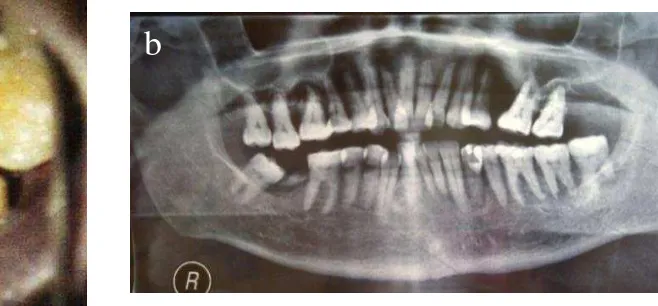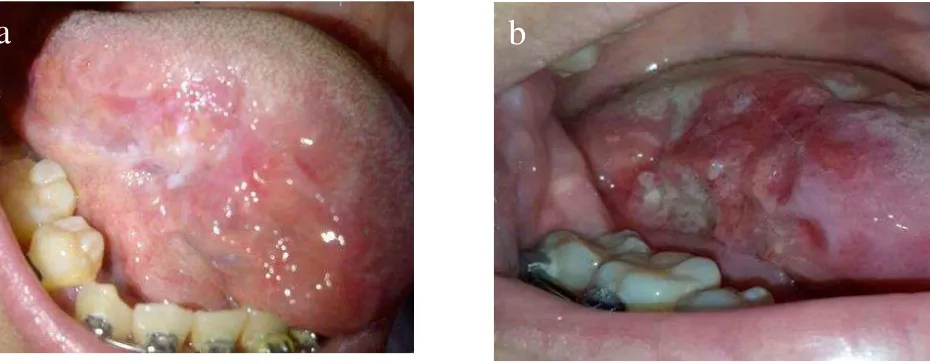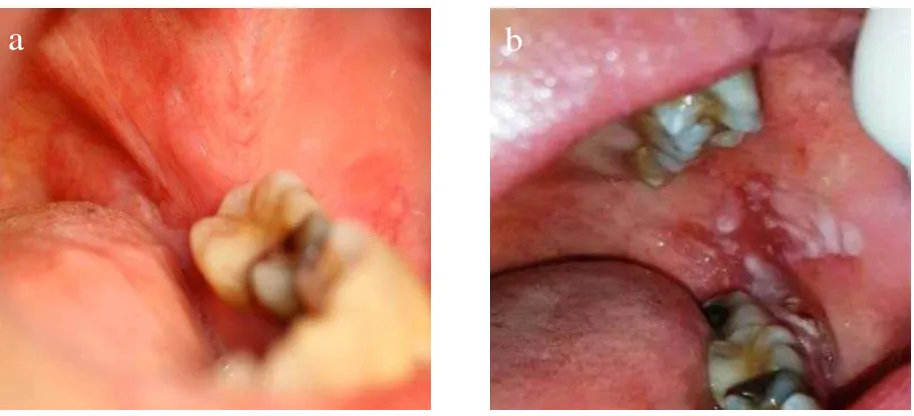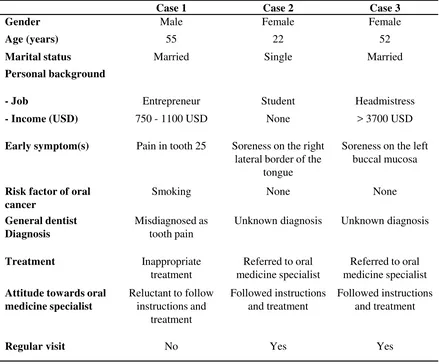The Importance of The Dentist
–
Patient Relationship
in Oral Cancer Treatment
Indrayadi Gunardi1, Rahmi Amtha1
1Department of Oral Medicine, Faculty of Dentistry, Trisakti University–Indonesia
‘CorrespondingAuthor:Indrayadi Gunardi, Faculty of Dentistry, Trisakti University–Indonesia. Email:indrayadigunardi@yahoo.com
Received date:July 10, 2017.Accepted date:September 11, 2017.Published date:September 29, 2017.
Copyright:©2017 Gunardi I, Amtha R. This is an open access article distributed under the terms of the Creative Commons Attribution License, which permits unrestricted use, distribution, and reproduction in any medium provided the original author and sources are credited.
Background:There are many instances in oral cancer cases in which a lack of patient cooperation was found to be a hampering factor in the overall case management. A good relationship between dentists and patients should therefore be built in conjunction with other treatment modalities. Case Report: Three complete oral cancer cases with dentist–patient relationship problems are presented. One of the common basic ways to build a good relationship is through communication and empathy. A relationship is also influenced by psychological distress, experience from previous treatments, socioeconomic factors, the healthcare system, time constraints, and belief.Conclusion:No single intervention strategy can improve the compliance of an oral cancer patient. An assessment of patient knowledge and understanding of the regimen along with clear and effective communication and trust in the therapeutic relationship are important in the overall patient management.
Keywords : compliance, oral cancer, perception
Oral cancer is the sixth most common cancers worldwide.1 Until now, there is no national data on
the epidemiology of oral cancer in Indonesia. However, there were 95 patients in the West Java province diagnosed with oral cancer from 2014 to 2015.2 In Cipto Mangunkusumo Hospital, the
nasopharyngeal cancer prevalence was 28.35% between 2000 and 2005 with trends increasing 2.6-fold and a predominance among males.3 An oral
cancer diagnosis is mainly based on histopathologic appearance. Smoking, drinking alcohol, and betel quid chewing are the known risk factors in Indonesia.4 Kretek cigarettes, traditional alcohol
are still cultural habits in the country.5 Moreover
the type of traditional alcohol are certainly different from conventional alcohol products such as beer, wine, and etc. No study has done to compare the effect of traditional and conventional alcohol drinking.
cost for treatment.6,7 There are also still many
negative attitudes from patients that do not seem to have a valid reason behind them.8–11
To the best of our knowledge, no literature exists on serial cases of oral cancer patient perception and compliance with dentist instructions in Indonesia. This paper will discuss several factors that influence the dentist–patient relationship in three oral cancer cases. At the end of this case report, the factors that contribute to a good dentist– patient relationship will be discussed.
First visit. A 55-year-old male came to Trisakti Dental Hospital complaining of continuous dull pain in his upper left gingiva that started six months ago. He also had difficulty speaking and chewing. The pain history started with swelling and sharp pain in his infected tooth. The dentist prescribed antibiotics and analgesics to relieve the pain and performed a tooth extraction one week later. The
pain still persisted after the extraction. The patient changed dentists often and took many medications without prescriptions, such as lincomycin, ciprofloxacin, mefenamic acid, natrium diclofenac, and dexamethasone, for six months without any improvement in the symptoms. The patient had a kretek smoking habit of one pack per day since junior high school. No alcohol consumption and no relatives with malignancy were found in the patient history.
The patient had gained weight five months prior to the visit to our hospital. Lethargy and moon face were found on physical examination. Palpation of the left submandibular lymph node revealed that it was hard and painful. The upper left gingiva of the
edentulous 25 region was ulcerated with a
corrugated texture, erythematous, and covered by white pseudomembranous lesions. An erythematous area was found after the pseudomembranous was scraped off. A panoramic radiograph showed a 11 x 4 mm radiolucency between tooth 25 and 26 reaching to the base of the left maxillary sinus (figure 1a and 1b).
a
b
The clinical diagnosis of acute pseudo-membranous candidiasis and oral squamous cell carcinoma arising on the upper left gingiva 25 was made by an oral medicine specialist. Nystatin was given for two weeks to eliminate the fungal infection. The patient was instructed to stop all previous medications and was scheduled for biopsy.
One week later, the patient did not come to the dental hospital for further treatment. The patient informed our hospital that he refused to come and receive any treatment at our facilities. Moreover, he was still taking several medications from a previous dentist but had stopped smoking. We explained the possible risks of his disease and urged him to seek intensive treatment in another hospital.
Second visit. Patient informed that two weeks before, the patient went to a government hospital for a biopsy and an extraction of tooth 26. The biopsy showed severe differentiation of oral squamous cell carcinoma. A CT scan showed third-stage oral squamous cell carcinoma. Patient weight loss was significantly more than 10 kg, and painful symptoms persisted with no relief from common analgesic medication. The patient was referred to
an oncologist. From the information taken by hospital staff, the patient passed away four months later during chemotherapy treatment and showed severe depression from a long-term history of pain.
First visit. A 22-year-old female referred by general dentist with unknwon oral lesion. Patient came to the dental hospital two years ago with complaints of soreness on the right lateral border of the tongue near tooth 46. There was no risk factor for oral cancer in the patient history. Intraoral examination revealed a white patch with striae on the right lateral border of the tongue with a single ulcer, no induration, and tenderness on palpation (figure 2a and 2b). Biopsy results showed a band of lymphocyte and liquefaction degeneration. The diagnosis was consistent with lichen planus without dysplastic changes. The treatment was a tongue frenectomy to eliminate the irritation and topical clobetasol three times a day for three months. The lesion improved clinically and subjectively, and the patient regularly attended check-up appointments every six months.
a
b
Second visit. One year later, the patient came in with white striae surrounded by a red ulcer and induration of the margin. Clinical VELscope® (Visually Enchanced Lesion scope; LED Dental Inc., Burnaby, BC, Canada) fluorecence showed a loss of fluorescence. A second biopsy was taken and the results still showed no dysplastic cells. Treatment with clobetasol was continued for three months.
Third visit. Three years after the first diagnosis, the patient came in with more pronounced pain and limited mobility of the tongue. The lymph node was palpable on the right side. Intraoral examination showed a red ulcer with an indurated margin. A third biopsy showed moderately differentiated squamous cell carcinoma. The patient was referred to an oncologist and passed away while receiving radiation therapy.
First visit. A 52-year-old female referred by general dentist with unknown oral lesion. Patient came in with complaints of soreness on the left buccal mucosa. Intraoral examination revealed a whitish lesions with an erythematous background on the gingiva and buccal mucosa in the last four months. The clinical diagnosis was erosive oral lichen planus. Stress on the job was found to be a risk factor. A biopsy was conducted with results that were consistent with the clinical diagnosis. Topical clobetasol was given as a treatment.
Second visit. Eleven months after the diagnosis,
the oral lesion become worse. The patient
complained of pain in the left cheek. Intraoral examination revealed more prominent whitish lesions with erosion, advancing to the buccal gingiva of tooth 46. A second biopsy was
conducted that showed invasive moderately
differentiated squamous cell carcinoma. The patient was referred to an oncologist (figure 3a and 3b).
a
b
Case 1 Case 2 Case 3
Gender Male Female Female
Age (years) 55 22 52
Marital status Married Single Married
Personal background
- Job Entrepreneur Student Headmistress
- Income (USD) 750 - 1100 USD None > 3700 USD
Early symptom(s) Pain in tooth 25 Soreness on the right
lateral border of the tongue
Soreness on the left buccal mucosa
Risk factor of oral cancer
Smoking None None
General dentist Diagnosis
Misdiagnosed as tooth pain
Unknown diagnosis Unknown diagnosis
Treatment Inappropriate
treatment
Referred to oral medicine specialist
Referred to oral medicine specialist
Attitude towards oral medicine specialist
Reluctant to follow instructions and
treatment
Followed instructions and treatment
Followed instructions and treatment
Regular visit No Yes Yes
Table 1.Patient background from each case
One common basic way to build a good
relationship is through communication and
empathy.12In all three cases, the same oral medicine
specialist tried to build a good relationship with the patient through communication within all visits. Psychological factors, socioeconomic factors, a support system, and patient beliefs were the strong points to build the relationship.
A high level of psychological distress, including worry, anxiety, and depression (whether subclinical or clinical), is common among oral cancer patients.
the diagnosis to months after the conclusion of treatment. Studies have shown that there is a link between the psychological and physiological features of cancer risk and progression through the activation of the hypothalamic–pituitary–adrenal axis in chronic stress responses and depression. This impairs the immune response, which contributes to the progression of cancer.13A study by Gagliese et
al.(2007) showed that depression is highly prevalent
of the cancer treatment.14 High psychological
distress is shown to hamper communication between patients and health providers, as was shown in the case of the first patient.
Several studies have found that patients with a high socioeconomic status show better compliance with the instructions of health providers.15 In these
case reports, socioeconomic status consisted of educational level, annual income, and access to healthcare. The high family socioeconomic status from patient number two helped her to cooperate and show better compliance with the treatment. On the contrary, the low socioeconomic status of patient number one led to difficult access to early patient care. This resulted in other problems, such as a long waiting time for appointments and difficulties in getting prescriptions, all of which increased the
patient’s psychological tension and jeopardized the
patient’strust in the dentist and the entire treatment process.15The lack of trust that was shown in the
first case resulted in bad case management. The patient continued using his old medications, which worsened his condition. It has been shown that the uncontrolled use of corticosteroid medications for a long period can make cancer progression more severe.16 The early detection of oral cancer and
proper counselling from the previous dentist should have helped the patient in receiving the subsequent oral cancer treatment provided by the specialists.17
Another factor that indirectly relates to patient compliance is belief. Apatient’s belief about illness and treatment are interconnected.18A higher level of
compliance can be achieved when the patient feels susceptible to the disease,19believes that the disease
could pose severe consequences,20 and believes that
the therapy will be effective or perceives benefits from the therapy.21
Although the article indicated the factors that considered important in dentist-patient relationships, some limitations hindered the author to have a strong conclusion. No psychological screening was done in the course of the treatment, and appointment time was too short for building patient’s trust, thus developing good relationship. All patients in this case report had signed informed consent documents from Dental Hospital of Trisakti University which allow the authors to publish their cases.
While no single intervention strategy can improve the compliance or adherence to instructions of all patients, most studies agree that a good dentist–patient relationship is an important factor in overall patient management. Psychological factors, socioeconomic factors, and patient beliefs have to be recognized by dentists to build a good relationship with oral cancer patients.
Thank you to Gabriella Nasseri, DDS for documenting the case; and Carolina Marpaung, MDS for editing the manuscript.
1. Stewart BW, Kleihues P Head and neck cancer. In Bernard W Stewart and Paul Kleihues, editors.
‘World Cancer Report’. Lyon France, IARC Press; 2003a. p.232-5
2. Maulinaa T, Iskandarsyahb A, Hardiantoa A, Sjamsudina E, Nandini M, Kasima A, et al. The incidence of oral squamous cell carcinoma (OSCC) and its relationship with orofacial pain in oral cancer patients in West Java Province, Indonesia. J Oral Maxillofac Surg Med Pathol. 2017;29:29-32.
3. Adham M, Kurniawan AN, Muhtadi AI, Roezin A, Hermani B, Gondhowiardjo S, et al. Nasopharyngeal carcinoma in Indonesia: epidemiology, incidence, signs, and symptoms at presentation. Chin J Cancer. 2012 Apr; 31(4): 185–196. doi: 10.5732/cjc.011.10328
4. Amtha R, Razak IA, Basuki B, Roeslan BO, Gautama W, Puwanto DJ, et al. Tobacco (kretek) smoking, betel quid chewing and risk of oral cancer in a selected Jakarta population. Asian Pac J Cancer Prev. 2014;15(20):8673-8.
5. Prabandari YS, Dewi A. How do Indonesian youth perceive cigarette advertising? A cross-sectional study among Indonesian high school students. Glob Health Action. 2016; 9: 10.3402/gha.v9.30914 6. KOMPAS. Kanker Masih Jadi Momok Menakutkan.
Update 4 Febuary 2010.
7. Maulana A. Masih Rendah, Kesadaran Masyarakat terhadap Kesehatan Gigi dan Mulut. Update 26 May 2014. http://www.unpad.ac.id/2014/05/masih-rendah- kesadaran-masyarakat-terhadap-kesehatan-gigi-dan-mulut/
8. Donovan JL, Blake DR. Patient non-compliance: deviance or reasoned decision-making?. Soc Sci Med. 1992;34:507–13.
9. Vermeire E, Hearnshaw H, Van Royen P, et al. Patient adherence to treatment: three decades of research A comprehensive review. J Clin Pharm Therap. 2001;26:331–42
10. Gordis L. Conceptual and methodologic problem in measuring patient compliance. In: Haynes B, Taylor DW, Sackett DL, editors. Compliance in health care. Baltimore: The John Hopkins University Press; 1979. p. 23–45.
11. Cummings KM, Kirscht JP, Binder LR, et al. Determinants of drug treatment maintenance among hypertensive persons in inner city Detroit. Public Health Rep. 1982;97:99–106.
12. Swaminath G. Doctor-patient communication: Patient perception. Indian J Psychiatry. 2007 Jul-Sep; 49(3): 150–153.
13. Reiche EM, Nunes SO, Morimoto HK. Stress, depression, the immune system, and cancer. Lancet Oncol. 2004 Oct;5(10):617-25.
14. Gagliese L, Gauthier LR, Rodin G. Cancer pain and depression: A systematic review of age-related patterns. Pain Res Manag. 2007 Autumn; 12(3): 205–
211.
15. Jin J, Sklar GE, Oh VMS, Li SC. Factors affecting therapeutic compliance: A review from the patient’s perspective. Ther Clin Risk Manag. 2008 Feb; 4(1): 269–286
16. Grivennikov SI, Greten FR, Karin M. Immunity, Inflammation, and Cancer. Cell. 2010 Mar 19; 140(6): 883–899.
17. Villa A, Kreimer AR, Pasi M, Polimeni A, Cicciù D, Strohmenger L, Gherlone E, Abati S. Oral Cancer Knowledge: A Survey Administered to Patients in Dental Departments at Large Italian Hospitals. J Cancer Educ. 2011 Sep; 26(3): 505–509.
18. Ross S, Walker A, MacLeod MJ. Patient compliance in hypertension: role of illness perceptions and treatment beliefs. J Hum Hypertens. 2004 Sep;18(9):607-13.
19. Spikmans FJ, Brug J, Doven MM, et al. Why do diabetic patients not attend appointments with their dietitian? J Hum Nutr Diet. 2003;16:151–8.
20. Loffler W, Kilian R, Toumi M, et al. Schizophrenic
patients’ subjective reasons for compliance and noncompliance with neuroleptic treatment. Pharmacopsychiatry. 2003;36:105–12.



